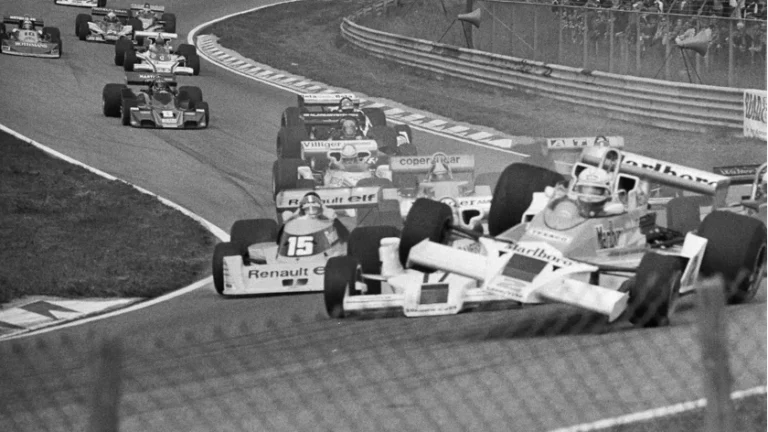1983 Monte Carlo Rally: A Battle of Engineering and Strategy
Picture by Brian Snelson
The biting cold of the French Alps in January 1983 wasn’t just a backdrop—it was a crucible. The Monte Carlo Rally, a jewel in the World Rally Championship’s crown, was already notorious for its unpredictable mix of snow, ice, and tarmac. But that year, it wasn’t just the weather that tested teams. It was a clash of engineering philosophies, driving styles, and bold strategies.
At the heart of the drama was the Lancia 037, a rear-wheel-drive machine seemingly outmatched by the rising tide of all-wheel-drive cars like Audi’s revolutionary Quattro. Yet against the odds, Lancia pulled off one of the most tactically brilliant victories in rally history—not through brute force, but through precision planning and a daring mid-stage tire change that turned the race on its head.
This is the story of how ingenuity beat innovation, and how the last rear-wheel-drive car to ever win the WRC did so on the sport’s most treacherous stage.
Overview of the 1983 Monte Carlo Rally
The Monte Carlo Rally has always been a gamble—where tire choice can make or break a stage, and one patch of black ice can derail even the most finely tuned car. In 1983, the rally stretched across over 600 competitive kilometers, snaking through alpine passes, frozen switchbacks, and slippery tarmac.
The field was packed with talent. Audi arrived with its four-wheel-drive Quattro A1, boasting raw power and traction that made it the favorite on snow-laden roads. Drivers like Hannu Mikkola and Michèle Mouton were well-versed in pushing the limits of this technological marvel. Peugeot and Opel brought strong entries, but it was clear the battle would be between Audi’s innovation and Lancia’s experience.
Adding to the drama was the unpredictability of Monte Carlo’s microclimates. Stages could begin on dry tarmac, transition into slush, and end in blinding snow—all within a single leg. For tire engineers and strategists, it was a logistical nightmare. For Lancia, it was a chance to exploit a narrow tactical window.
Lancia’s Position Entering the Rally
Entering 1983, Lancia found itself in a precarious position. Their rally weapon—the 037—was fast, agile, and beautifully balanced. But it had one fundamental flaw: it was rear-wheel drive. Against Audi’s dominant quattro system, the 037 lacked traction, particularly on icy terrain where power distribution could make or break a run.
Yet Lancia wasn’t short on leadership. At the helm was Cesare Fiorio, a visionary team manager who understood that if Lancia couldn’t out-muscle Audi, it had to out-think them. Fiorio didn’t believe in excuses. He believed in seizing the opportunities the regulations allowed—and sometimes, the ones they didn’t explicitly forbid.
He knew the 037’s strength lay in its light weight and superior handling on dry surfaces. So he focused the team’s efforts not just on car performance but on tactical ingenuity—preparing them for an all-out mental and logistical chess match.
Group B Rally Cars: The Pinnacle of Rally Innovation
Understanding Group B Regulations
The 1980s ushered in what many still consider rallying’s most exhilarating and dangerous era: Group B. Introduced by the FIA in 1982, Group B regulations allowed for minimal restrictions on power, weight, and technology. Manufacturers had to build only 200 homologation units for competition, meaning race-bred monsters could be born with little compromise.
The result was a generation of cars that were brutally fast and, in some cases, frighteningly difficult to control. Horsepower figures soared past 500 bhp by mid-decade, and weight-saving measures pushed the limits of safety. For fans, it was a golden age. For drivers, it was a white-knuckle challenge.
But this also meant that success wasn’t solely about who could build the most powerful car. It was about who could harness that power wisely—especially in a rally like Monte Carlo, where traction and timing often mattered more than outright speed.
The Lancia 037’s Design and Engineering
The Lancia 037 stood as a unique answer to the Group B challenge. Instead of following the all-wheel-drive trend, Lancia committed to refining a rear-wheel-drive chassis, trusting in balance, simplicity, and strategic tire management.
Under its sleek fiberglass skin, the 037 featured a mid-mounted, supercharged 2.0-liter four-cylinder engine producing around 325 horsepower. Supercharging, rather than turbocharging, ensured immediate throttle response—critical for tight, technical stages.
Weighing just over 960 kg (2,116 lbs), the 037 was featherlight compared to its rivals. Its tubular steel chassis and Kevlar body panels gave it agility unmatched on dry tarmac. The rear-wheel-drive setup allowed for razor-sharp steering, but the price was paid on snow and ice, where grip was scarce.
In pure engineering terms, it was both a masterstroke and a gamble.
Monte Carlo Rally Tactics: Lancia’s Innovative Approach
The Mid-Stage Tire Change Strategy
What set Lancia apart in Monte Carlo wasn’t just the 037—it was how the team used it. Knowing the car’s limitations on slippery surfaces, Fiorio and his engineers borrowed a tactic from another form of motorsport: Formula 1.
The concept was bold—changing tires mid-stage, rather than between stages, to adapt to constantly evolving road conditions. While rallying had always involved tire choice, the idea of stopping within a timed section was almost unheard of. It meant losing precious seconds voluntarily—but with the promise of gaining far more over treacherous terrain.
In theory, it was madness. In practice, it was genius.
Fiorio’s team identified specific stages where conditions shifted dramatically—from snow at altitude to dry tarmac at lower elevations. By placing support crews at pre-selected points (technically outside official service areas), drivers could switch from studded tires to slicks mid-stage, maximizing performance across both surfaces.
The inspiration came from pit stop logic: sacrifice a bit of time now to make up chunks later. The gamble was whether the stages were long and variable enough to make that investment worthwhile.
Execution During the Rally
The execution was surgical. Tire crews waited discreetly at roadside lay-bys, dressed like spectators to avoid attention. Röhrl or Alén would stop for less than 30 seconds, hop out, and help swap tires themselves—a seamless ballet of speed, strategy, and nerve.
In stages like Sisteron–Thoard, where conditions could vary wildly over just a few kilometers, the effect was transformative. Rivals struggled for grip as conditions changed beneath them. Röhrl, equipped with the perfect tire at the perfect moment, simply disappeared into the distance.
Time lost? Around half a minute. Time gained? Sometimes over a minute per stage. The math added up, and more importantly, so did the psychology—it rattled the competition.
The Salt Spreading Controversy
While the mid-stage tire change was innovative, another tactic used by Lancia during the 1983 Monte Carlo Rally stirred deeper controversy: the strategic use of salt.
In select snow-covered sections, members of Lancia’s extended support team—often posing as local spectators—were spotted spreading salt on the road ahead of their drivers’ runs. The intention was clear: melt just enough snow and ice to provide a grip advantage to the rear-wheel-drive 037, which struggled in low-traction conditions.
Salt melting snow wasn’t a new concept in road maintenance. But in the heat of a world championship rally, it raised serious ethical questions. Was it a clever interpretation of the rules—or blatant manipulation?
While the FIA had no specific regulation prohibiting this act at the time, rival teams were outraged. Audi, in particular, saw it as underhanded and unsporting, especially as their quattro system relied on consistent snowy conditions to maximize its all-wheel-drive advantage. What made the matter murkier was the lack of any formal protest or penalty—the tactic lived in a regulatory gray zone.
Fiorio, ever the strategist, defended the approach as simply being better prepared. His philosophy was straightforward: “If it’s not in the rulebook, it’s not illegal.” That attitude defined much of Lancia’s 1983 campaign—and it paid off.
Lancia 037 Strategy: Turning Disadvantages into Triumphs
Overcoming the Odds
What made Lancia’s 1983 Monte Carlo victory so significant wasn’t just that they won—it was how they won. Against a backdrop of overwhelming odds, the team turned every supposed disadvantage into a strategic asset.
The 037 wasn’t the most powerful car. It lacked the traction of all-wheel-drive rivals and wasn’t the easiest to manage in mixed conditions. But it was light, responsive, and driven by two of the most versatile and disciplined drivers in rally history.
Walter Röhrl, with his calculated approach and razor-sharp instincts, knew exactly when to push and when to preserve. Markku Alén brought fearless energy and resilience, willing to extract every ounce of performance from the car. Together, they executed Lancia’s unconventional tactics to near perfection.
From pre-stage reconnaissance to in-stage tire swaps and backroad salting, everything was orchestrated with military precision. Lancia knew their limitations, but instead of fighting them, they adapted around them—and made the unpredictable Monte Carlo conditions work in their favor.
The Impact on Rallying
Lancia’s approach in Monte Carlo didn’t just earn them a trophy—it changed the strategic thinking in rallying. Teams began to see rallies not merely as speed contests, but as tactical battlegrounds. The idea of dynamic strategy, akin to that of circuit racing, entered the WRC’s mainstream consciousness.
The concept of support crews playing a bigger role mid-stage, though controversial, became a topic of serious debate. Meanwhile, the FIA took notice. In the years that followed, regulations surrounding service areas and external assistance would become far stricter—largely in response to Lancia’s unorthodox tactics.
But for a brief moment in 1983, the rulebook hadn’t yet caught up. And Lancia used that window to write one of the most legendary chapters in rally history.
Lancia 037 Pit Stop: A Closer Look
Mechanics of the Mid-Stage Pit Stops
Performing a pit stop in the middle of a rally stage required planning that bordered on espionage. Crews had to remain low-profile—camouflaged as bystanders, ready to leap into action for a window of less than a minute.
Each stop location was chosen based on three factors:
- Road Surface Transition: A stage that started in snow but ended in dry tarmac.
- Driver Familiarity: The driver needed to know precisely where to stop and what tires to expect.
- Safety and Visibility: Locations that wouldn’t put the car or crew in danger from traffic or other competitors.
The tires were stored nearby, sometimes hidden behind trees or in vans marked inconspicuously. Röhrl would pull up, jump out, and assist in the change, shaving seconds off the total time. These weren’t leisurely swaps—they were high-pressure, high-stakes decisions executed with military precision.
Performance Metrics
So, was the mid-stage stop really worth it?
According to data from the 1983 Monte Carlo stages:
| Stage | Stop Time (approx.) | Time Gained | Net Benefit |
|---|---|---|---|
| Sisteron–Thoard | ~25 seconds | 1:15 | +50 seconds |
| Col de Turini (night) | ~30 seconds | 1:00 | +30 seconds |
| Saint-Auban–Briançonnet | ~20 seconds | 45 seconds | +25 seconds |
Opportunities for Further Engagement
Exploring the Lancia 037 Today
For enthusiasts eager to experience the legend firsthand, the Lancia 037 can still be seen in action—and in pristine condition—at several prestigious locations and events around the world.
- Heritage HUB, Turin (Italy): Stellantis’ official collection houses one of the best-preserved examples of the 037, displayed with detailed documentation from the 1983 season.
- Goodwood Festival of Speed: This annual British motorsport event often features classic Group B cars, including the 037, driven by historic figures or current racing legends.
- Rétromobile, Paris: One of Europe’s most important classic car shows, Rétromobile frequently showcases rally icons, and the 037 is a regular attraction.
- Rally Legends San Marino: This fan-favorite historic rally gathering lets you see (and hear) the 037 being driven in anger across mountainous terrain, echoing its Monte Carlo glory.
For those looking to dive deeper into the 1983 Monte Carlo Rally:
- “Racing Through the Night: Monte Carlo Rally 1983” – A documentary featuring interviews with Fiorio and Röhrl, with rare behind-the-scenes footage of the rally.
- Books like Rally Giants: Lancia 037 by Peter Collins offer deep dives into the car’s development, race-by-race history, and technical blueprints.
Whether you’re a die-hard rally historian or a casual motorsport fan, exploring the 037’s story in person or through these media is a compelling way to connect with one of the most daring victories in WRC history.
Final Thoughts
The 1983 Monte Carlo Rally was more than just a race—it was a turning point in rally history. Lancia’s 037, facing the looming dominance of all-wheel-drive technology, didn’t win by brute force. It won with bold decisions, deep understanding of conditions, and an unwavering belief in the team’s ability to outsmart rather than overpower.
Cesare Fiorio’s leadership turned what many considered a handicap—rear-wheel-drive—into a strategic puzzle waiting to be solved. With Röhrl and Alén behind the wheel, and a support team working with military-like precision, the 037 carved its place in motorsport history not because it should have won—but because no one else would have dared to try that hard to win.
The legacy of that winter in 1983 endures today. Every innovative tactic, every ethical debate, every second gained or lost—these moments remind us why motorsport is not just about machines, but the people behind them.
And sometimes, the most brilliant victories are the ones engineered in the shadows, far from the podium’s spotlight.
Frequently Asked Questions (FAQs)
Why was the Lancia 037’s victory in 1983 significant?
The 1983 Monte Carlo Rally marked the final time a rear-wheel-drive car won in the World Rally Championship. This made the 037’s win historic, as it proved that strategy and innovation could overcome technological disadvantages—especially against the era-defining Audi Quattro.
How did mid-stage tire changes work during the rally?
Lancia set up hidden tire depots along the route, often with disguised crew members who helped drivers switch from snow tires to slicks mid-stage. These changes helped optimize grip as road surfaces transitioned from snow to dry tarmac.
Was spreading salt on the stages legal?
At the time, the FIA did not have a rule specifically prohibiting the use of salt. However, it was highly controversial and viewed by many competitors as unethical. No official penalty was ever issued, though the act fueled debates about fair play in motorsport.
What challenges did the Lancia 037 face against all-wheel-drive competitors?
The 037’s rear-wheel-drive layout meant it struggled for traction on snowy and icy surfaces, especially when compared to the all-wheel-drive Audi Quattro. Lancia had to rely heavily on smart strategies, superior driving, and meticulous preparation to stay competitive.
Where can I learn more about the Lancia 037 and its history?
Museums such as the Heritage HUB in Turin offer physical exhibits, while documentaries, motorsport books, and archives like Rallypedia provide extensive insights into the 037’s development, performance, and racing legacy.







